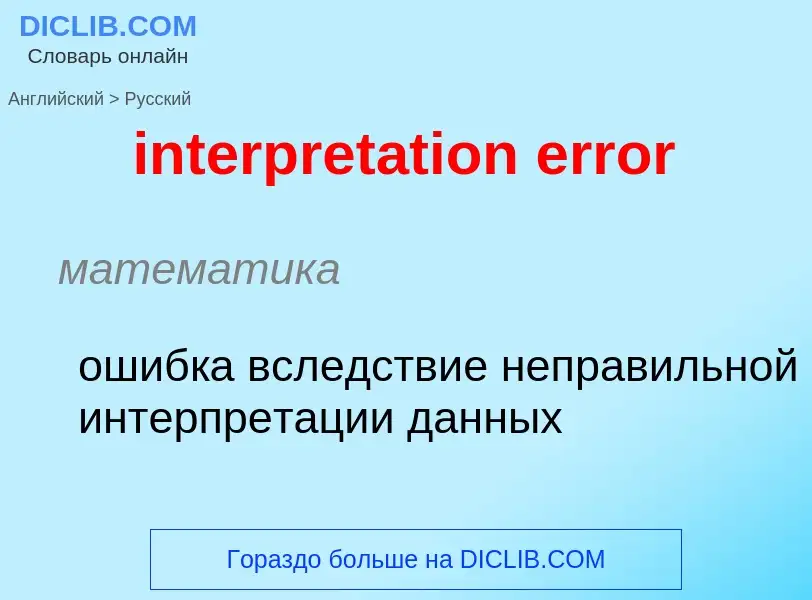Перевод и анализ слов искусственным интеллектом ChatGPT
На этой странице Вы можете получить подробный анализ слова или словосочетания, произведенный с помощью лучшей на сегодняшний день технологии искусственного интеллекта:
- как употребляется слово
- частота употребления
- используется оно чаще в устной или письменной речи
- варианты перевода слова
- примеры употребления (несколько фраз с переводом)
- этимология
interpretation error - перевод на русский
математика
ошибка вследствие неправильной интерпретации данных
Определение
Ошибка, оговорка, досадный промах (обычно в устной речи и на письме).
Википедия
Heritage interpretation refers to all the ways in which information is communicated to visitors to an educational, natural or recreational site, such as a museum, park or science centre. More specifically it is the communication of information about, or the explanation of, the nature, origin, and purpose of historical, natural, or cultural resources, objects, sites and phenomena using personal or non-personal methods. Some international authorities in museology prefer the term mediation for the same concept, following usage in other European languages.
Heritage interpretation may be performed at dedicated interpretation centres or at museums, historic sites, parks, art galleries, nature centres, zoos, aquaria, botanical gardens, nature reserves and a host of other heritage sites. Its modalities can be extremely varied and may include guided walks, talks, drama, staffed stations, displays, signs, labels, artwork, brochures, interactives, audio-guides and audio-visual media. The process of developing a structured approach to interpreting these stories, messages and information is called interpretive planning. The thematic approach to heritage interpretation advocated by University of Idaho professor Sam Ham, the National Association for Interpretation, the US National Park Service, and others, is considered best practice.
Those who practice this form of interpretation may include rangers, guides, naturalists, actors (who may wear period dress and do reenactments), museum curators, natural and cultural interpretive specialists, interpretation officers, heritage communicators, docents, educators, visitor services staff, interpreters or a host of other titles. The interpretive process is often assisted by new technologies such as visualizing techniques.

![Part of the music education for children in primary school is to assemble a do-organ from [[Orgelkids]] Part of the music education for children in primary school is to assemble a do-organ from [[Orgelkids]]](https://commons.wikimedia.org/wiki/Special:FilePath/2013 Orgelkids Doe-orgel toetsen verbinden aan de windlade.jpg?width=200)
![A [[park ranger]] at [[Biscayne National Park]] in Florida, USA, show a [[hermit crab]] to children. A [[park ranger]] at [[Biscayne National Park]] in Florida, USA, show a [[hermit crab]] to children.](https://commons.wikimedia.org/wiki/Special:FilePath/Biscayne National Park H-ranger kids hermit crab.jpg?width=200)
![Nuremberg defendants]] at dock listening to simultaneous interpretation Nuremberg defendants]] at dock listening to simultaneous interpretation](https://commons.wikimedia.org/wiki/Special:FilePath/Defendants in the dock at nuremberg trials.jpg?width=200)
![operation]] to his [[servant]], who acts as an interpreter operation]] to his [[servant]], who acts as an interpreter](https://commons.wikimedia.org/wiki/Special:FilePath/Dr. Thomas Colledge with Patients.jpg?width=200)
.jpg?width=200)

![Interpreter (left) next to Swedish filmmaker [[Johannes Nyholm]] at [[Buenos Aires International Festival of Independent Cinema]] 2019 Interpreter (left) next to Swedish filmmaker [[Johannes Nyholm]] at [[Buenos Aires International Festival of Independent Cinema]] 2019](https://commons.wikimedia.org/wiki/Special:FilePath/Johannes Nyholm presenting Koko-di Koko-da at BAFICI 2019.jpg?width=200)
![Simultaneous interpreter's station (Televic Conference) at the [[European Court of Justice]] Simultaneous interpreter's station (Televic Conference) at the [[European Court of Justice]]](https://commons.wikimedia.org/wiki/Special:FilePath/Simultandolmetscheranlage.jpg?width=200)
![[[Stéphane Brizé]] (second from the right) speaking in French in [[Buenos Aires]] in 2019. Seated to his left, the interpreter (on the extreme right) waits to translate into Spanish. [[Stéphane Brizé]] (second from the right) speaking in French in [[Buenos Aires]] in 2019. Seated to his left, the interpreter (on the extreme right) waits to translate into Spanish.](https://commons.wikimedia.org/wiki/Special:FilePath/Stéphane Brizé in Buenos Aires in 2019.jpg?width=200)
![A US military interpreter sits with Afghan army soldiers, [[Ghazni province]]. A US military interpreter sits with Afghan army soldiers, [[Ghazni province]].](https://commons.wikimedia.org/wiki/Special:FilePath/U.S. Army Sgt. Bardia Afsari, left, a translator assigned to the 1st Brigade Combat Team, 82nd Airborne Division, talks with Staff Sgt. John Evans, right, assigned to 340th Military Information Support Team 120528-A-NI188-030.jpg?width=200)
